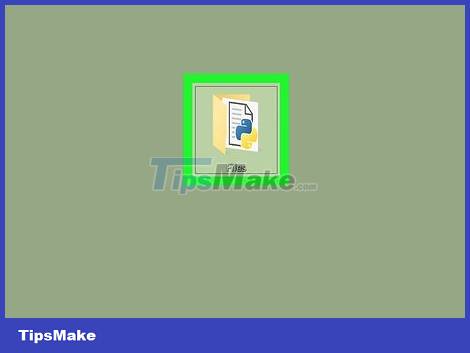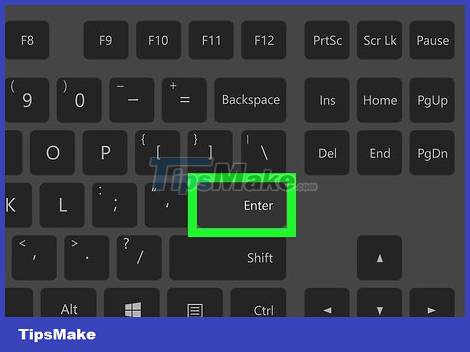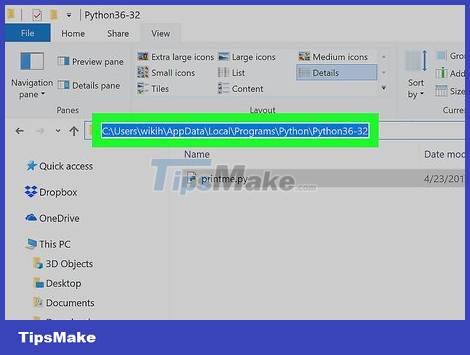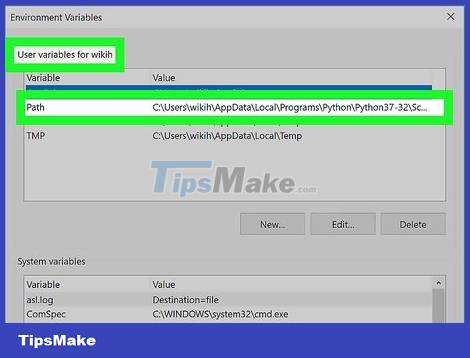How to Launch Python Files Using Windows Command Prompt
Find Python file path

Go to the directory containing the Python file. Find the Python file you want to open on Command Prompt.
If you already know the directory path of the Python file you want to open, you can open the file on Command Prompt immediately.

Select the Python file. Click on the Python file for which you want to view the directory path.

Right click on the Python file. A menu will drop down.

Click the Properties option in the drop-down menu. The Properties window will open.

Record the "Location" value. The directory address (or "path") to the right of the "Location" heading is the information you need to enter into the Command Prompt to switch to the directory containing the Python file.
You can copy a location by highlighting the information (click and drag over the "Location" value) and then press Ctrl+ C.
Launch the Python file

Open Start . Click the Windows icon in the lower left corner of the screen. The Start menu will pop up.

Find Command Prompt. Type cmdto find Command Prompt.

Click the Command Prompt program that appears at the top of the Start menu. Command Prompt will open.

Switch to the directory containing the Python file. Enter the command cdand a space, then enter the "Location" address of the Python file and press ↵ Enter.
For example, to open a Python file located in the "Files" folder on the Desktop, you need to enter cd desktop/Fileshere.
If you copied the file path, enter it cdwith a space and press Ctrl+ Vto paste the path.

Enter the command "python" along with the file name to open. Enter the command python file.py, which replaces file with the Python filename.
For example, if the Python file is named "script" then you need to enter it python script.pyhere.
If the Python file has more than one space in the name, we will enclose the name and file extension between quotation marks (e.g., python "my script.py").

Press ↵ Enter. The command will be executed and open the Python file in the Python program available on the computer.
If an error 'python' is not recognized as an internal or external commandappears after pressing Enter , you need to add Python to the PATH list and try again.
Add Python to the PATH list

Show hidden folders. Since one of the folders containing the Python installation directory is most likely hidden, we need to unhide them before continuing:
Open File Explorer.
Click the View tab.
Check the "Hidden items" box.

Go to the Python directory. In some cases, the path to Python will be "C:Python27"; however, if you installed the latest version of Python using the default settings, the program will be in a hidden folder. You can copy the appropriate file path by:
Click This PC on the left side of the File Explorer window.
Double-click the hard drive located in the "Devices and drives" section.
Scroll down and double-click the "Users" folder.
Double-click the folder with your username.
Scroll down and double-click "AppData".
Double click "Local".
Scroll down and double-click "Programs".
Double-click the "Python" folder.
Double-click the Python folder along with the appropriate version number (for example, "Python36").

Copy the path to the Python folder. Click the address bar at the top of the File Explorer window to highlight the content, then press Ctrl+ Cto copy the address.

Open the Power User menu. To proceed, right-click the Start icon . A menu will pop up.
You can also press ⊞ Win+ Xto open the Power User pop-up menu.

Click the System option . It's in the pop-up menu. A new window will open.

Click System info . This link is in the upper right corner of the window. The System Information window will open.

Click the Advanced system settings link . This link is in the upper left of the System Information window. At this point, another window will pop up.

Click Environment Variables… (Environment variables). This option is in the lower right corner of the pop-up window.

Find the "Path" heading in the "User variables" table. This pane is at the top of the Environment Variables window.
You may need to scroll your mouse pointer up or down on the "User variables" box to find the "Path" variable.

Double-click the "Path" heading. A window will pop up.

Click the New option . It's on the right side of the window. A text field will appear in the middle of the window.

Paste the path you copied earlier. Press Ctrl+ Vto paste the content. The path you copied will appear in the text field in the middle of the window.

Click OK on the three open windows. The system will save the changes and close the three windows "Path", "Environmental Variables" and "System Properties".
 How to Hack Gmail
How to Hack Gmail How to Uninstall iTunes
How to Uninstall iTunes How to Type the Heart Symbol in Windows
How to Type the Heart Symbol in Windows How to Reduce PDF File Size
How to Reduce PDF File Size How to Extract ZIP Files
How to Extract ZIP Files How to Record Voice on Computer
How to Record Voice on Computer